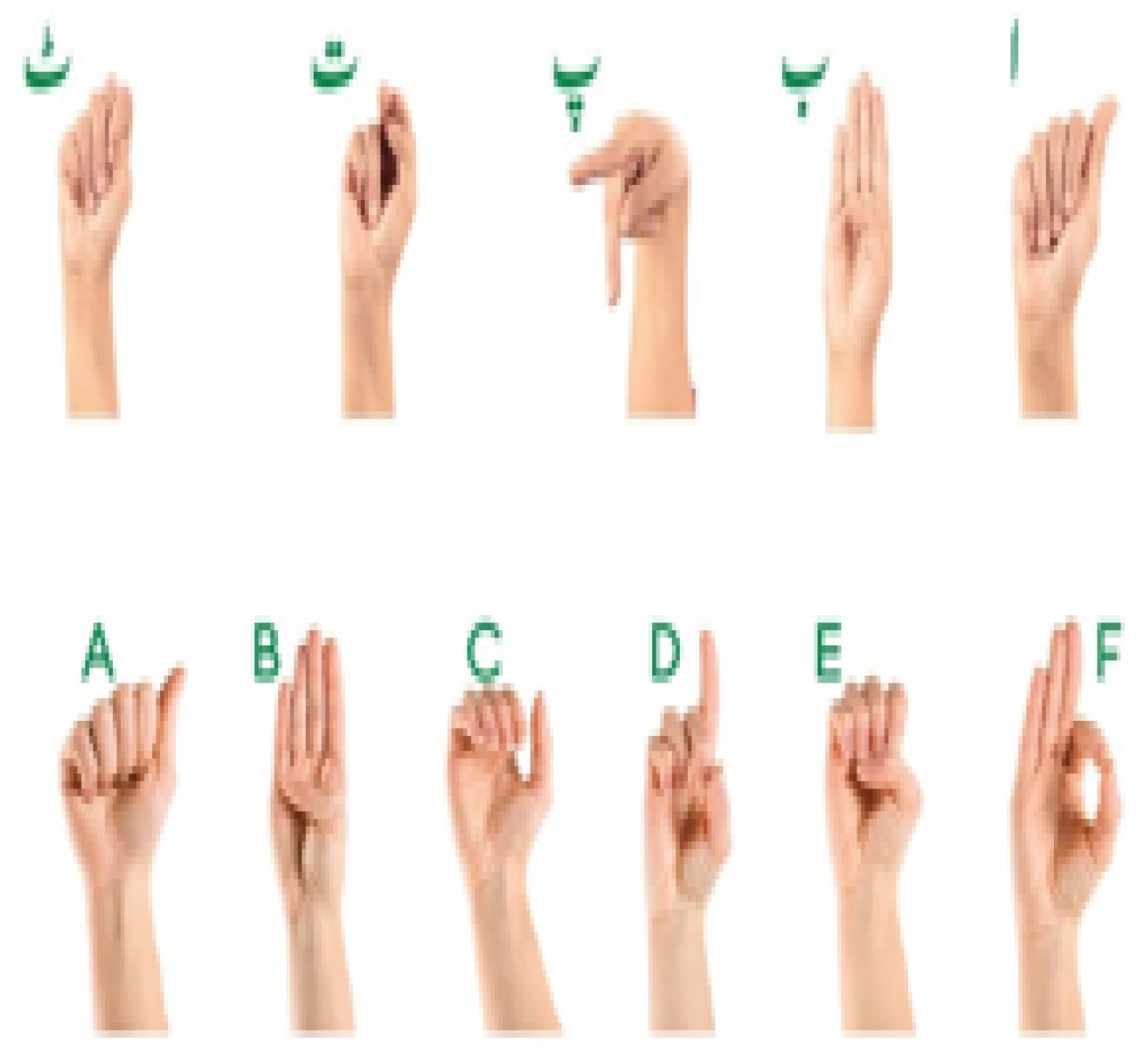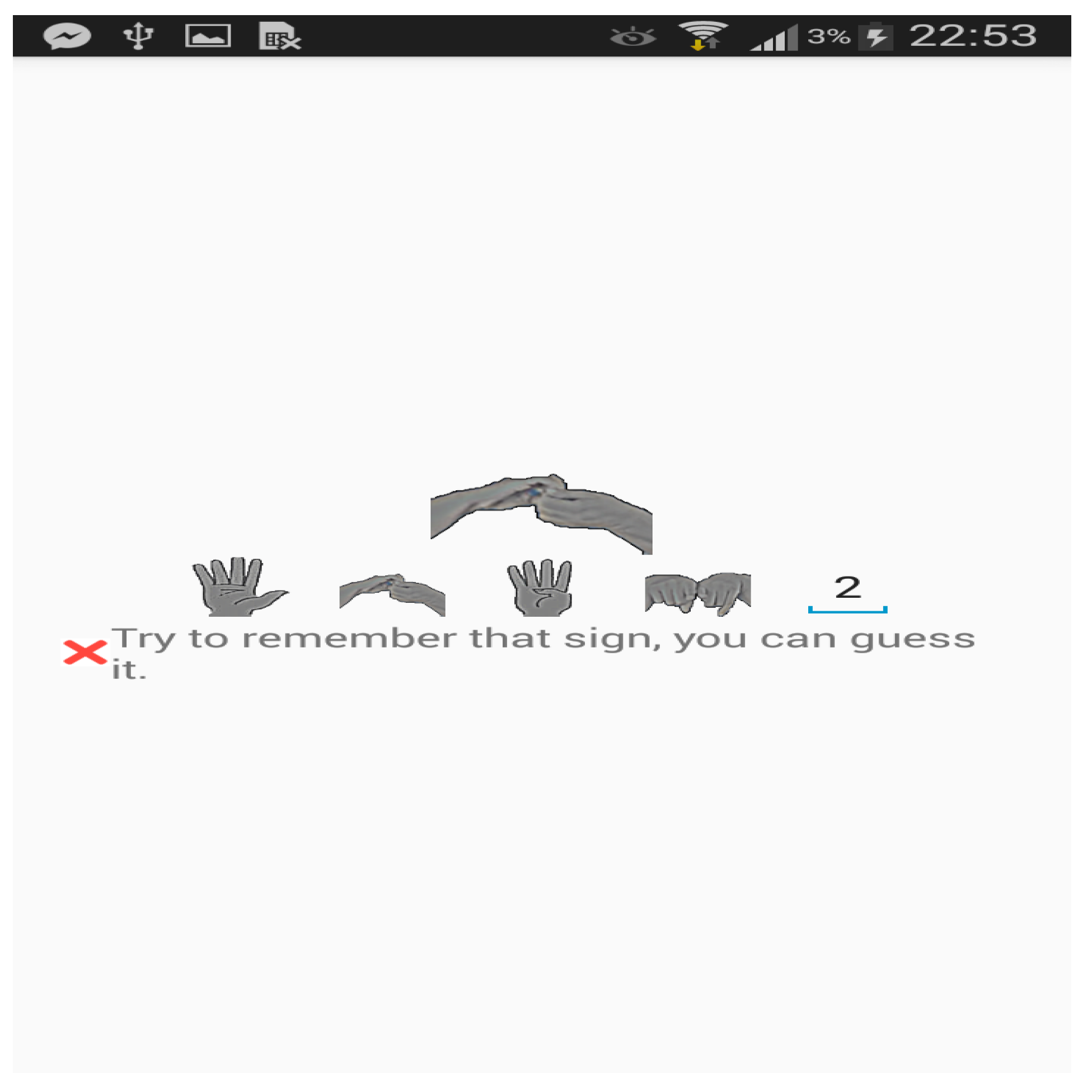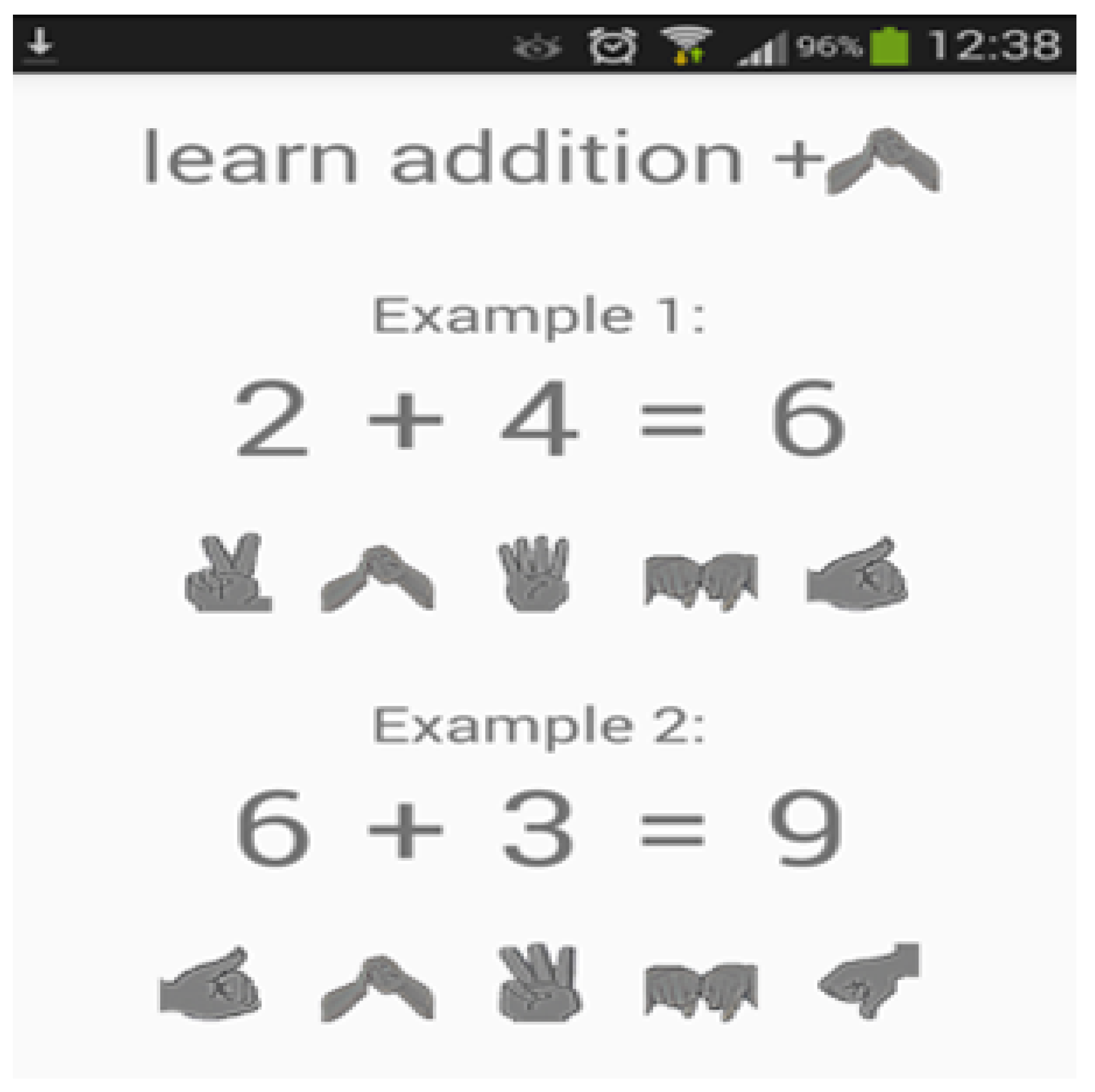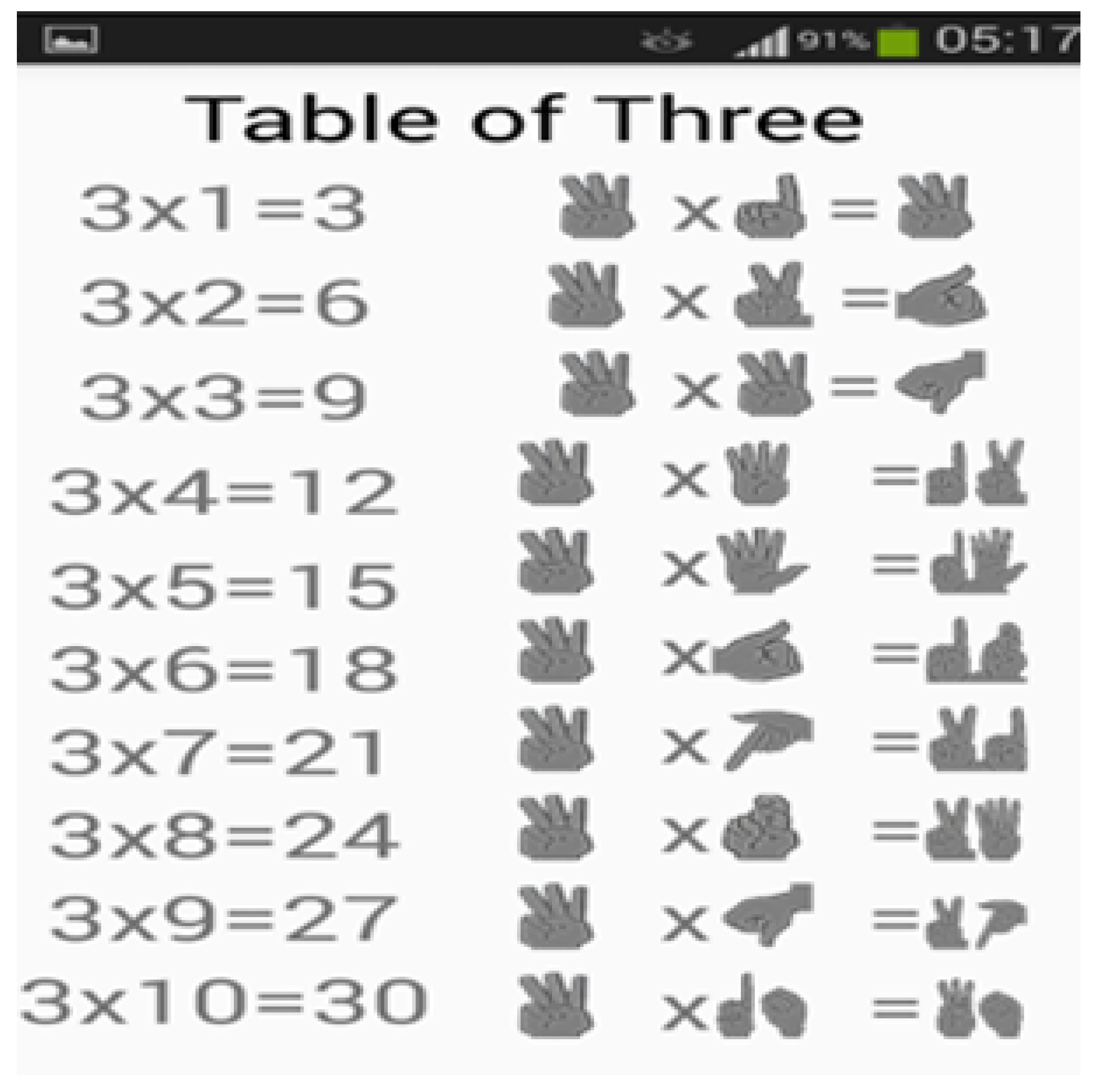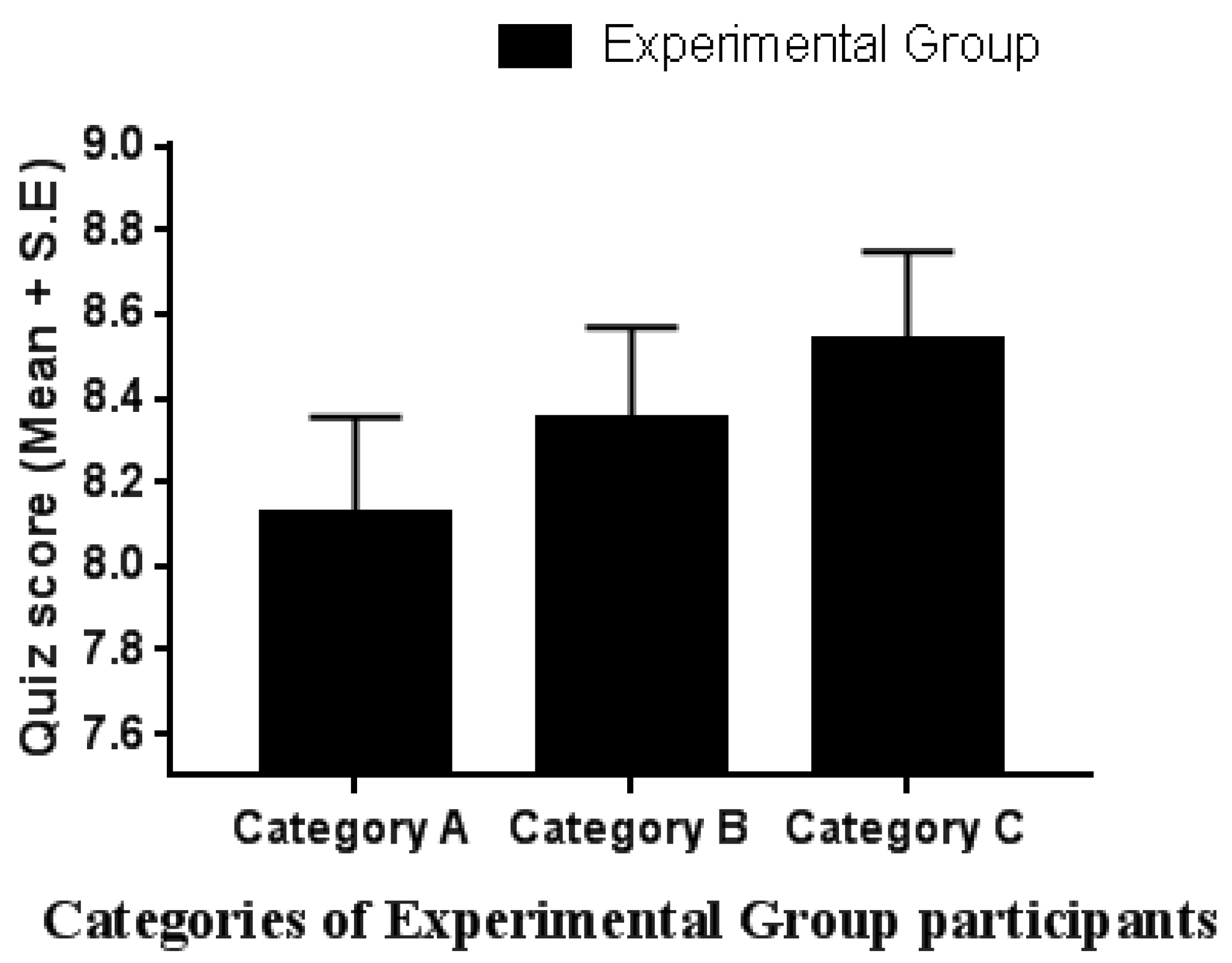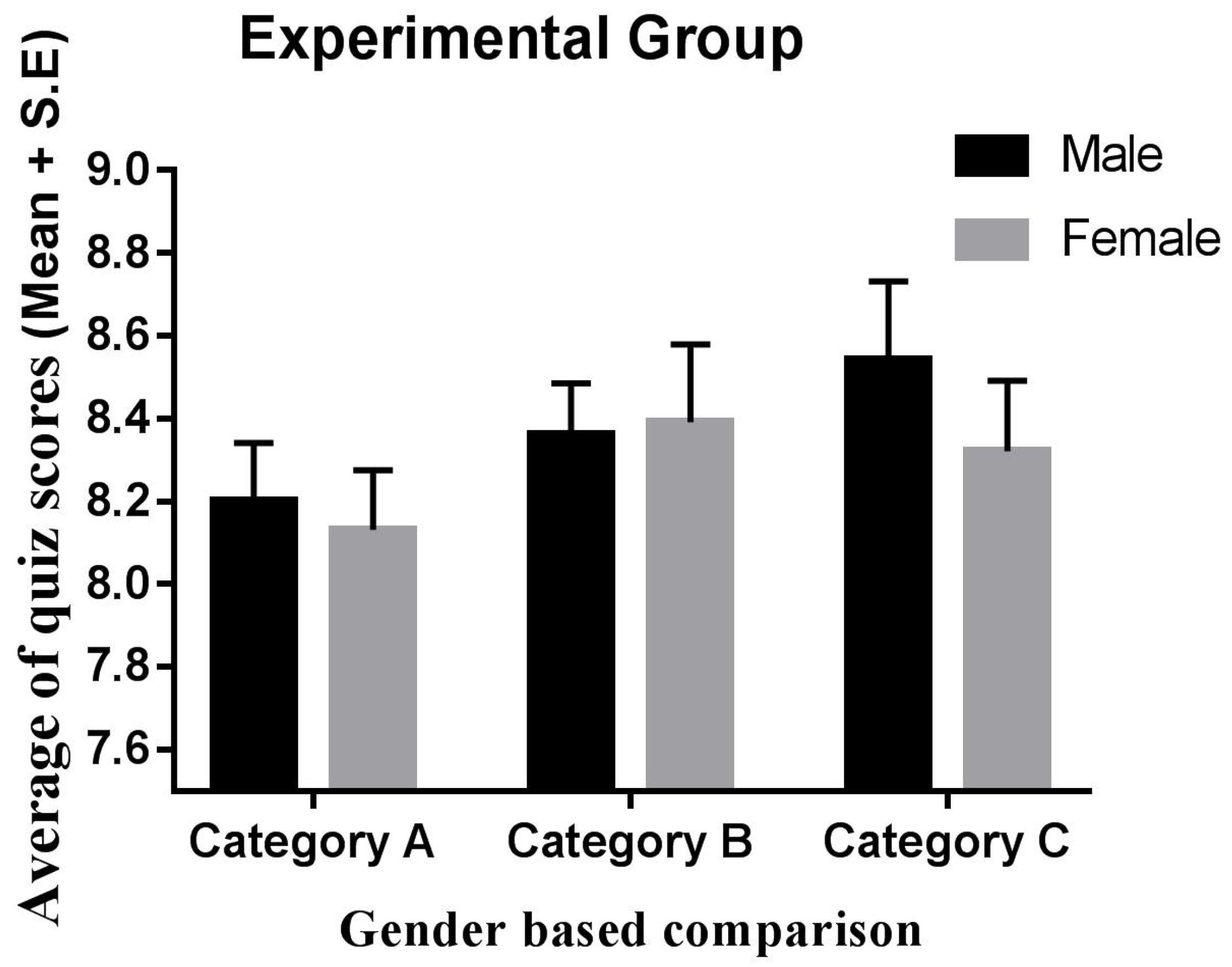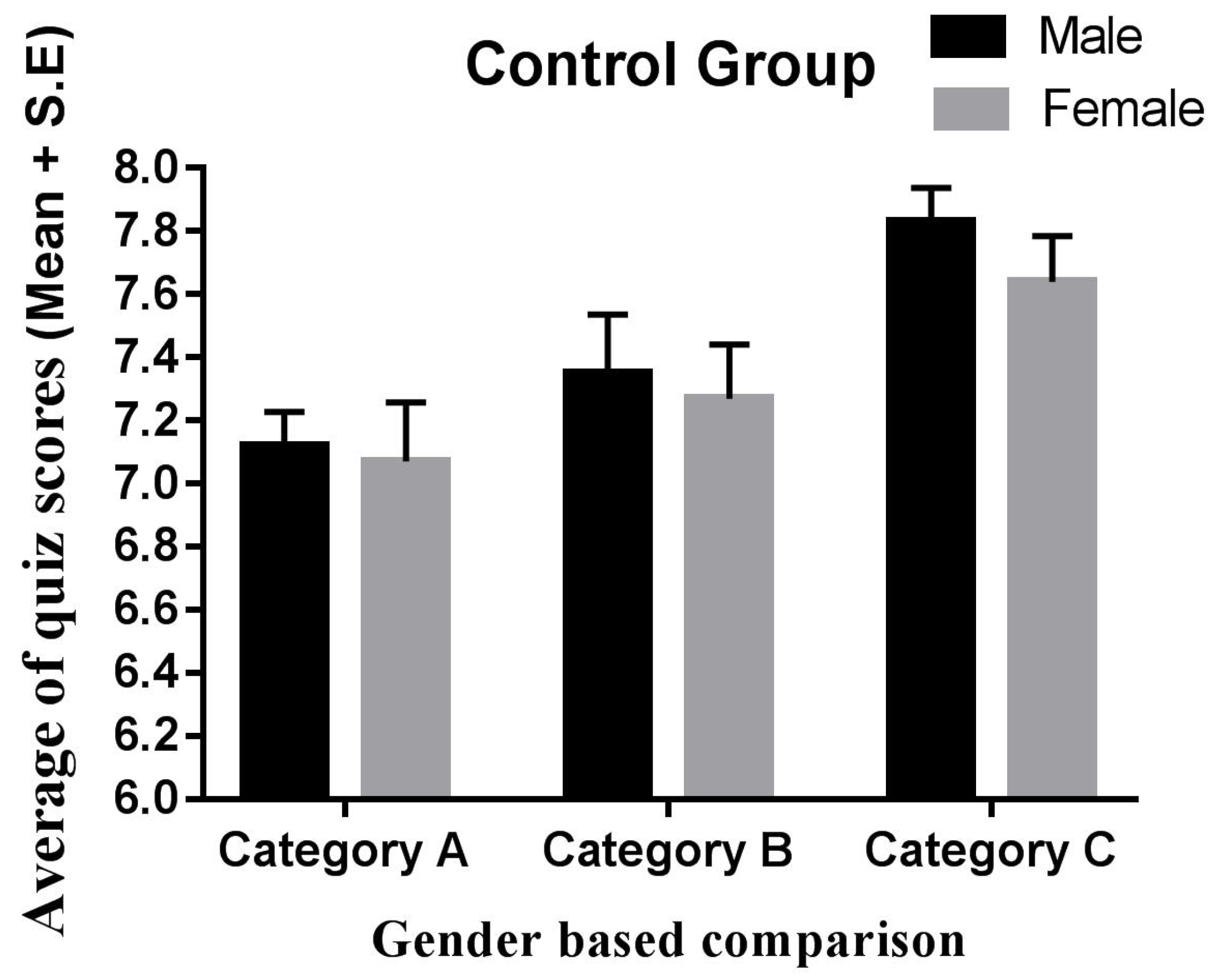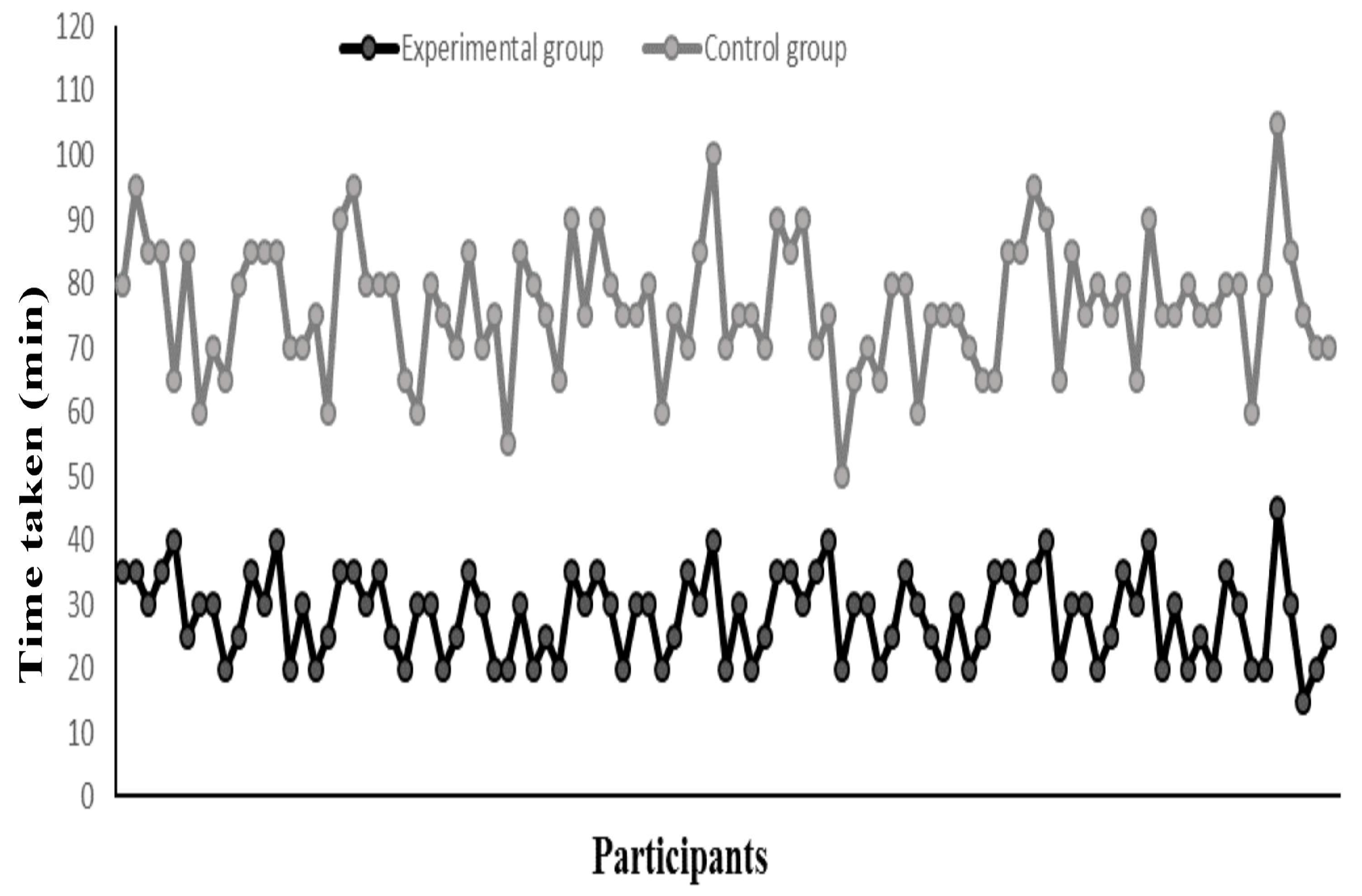1. Introduction
Deafness means the inability of a person to completely hear any type of sound [
1]. According to the World Health Organization (WHO) report on childhood hearing loss, there are different degrees of hearing loss [
2]. In case of mild loss, a person face difficulties in hearing soft and distant sounds. If the loss is profound, a person is unable to hear any sound. Genetics, diseases, ear infection, exposure to loud noise, and use of some medicine are the major causes of deafness [
3]. In Pakistan, about 0.48% of the total population is comprised of disabled people, of which 7.43% are deaf [
4,
5]. In daily life, people interact with each other via language, which serves as a medium of communication. Usually, communication falls into two categories, namely verbal and non-verbal. Verbal communication has a well-defined vocabulary and grammatical structure for hearing persons. Non-verbal communication mainly consists of visual/hand gestures typically used by deaf people. The concept of non-verbal communication is strongly related to Sign Language (SL). SL is a well-known means of communication for the deaf and people with hearing difficulty. SL is expressed with hand gestures, facial expressions, body movements and signs [
6]. It is worth noting that there is no universal SL and every country has its own SL. SL varies from one region to another. Until now, about 138 SLs are known [
7]. Different countries have developed SLs, for example, American Sign Language (ASL), Malaysian Sign Language (MSL), and British Sign Language (BSL). Similarly, Pakistan Sign Language (PSL) was developed for deaf people living in Pakistan [
8]. The combination of SL with spoken language results in different signs. For example, English spoken language combines with BSL to form English signs. Similarly, when Urdu language combines with PSL it forms Urdu signs. Initially, the development of PSL started at an individual level and was then further extended by various organizations. The first PSL dictionary provides 750 different words related to different topics [
8]. Like any other language, PSL has its own syntax.
Figure 1 represents some Urdu and English letters in PSL, which are presented differently as compared to other SLs. Using PSL, deaf people combine their hand gestures, arms and body movements to express their thoughts and feelings [
9].
Students with hearing ability learn by listening to their instructors, verbally giving feedback and asking questions. The same learning process is different for deaf students [
11]. They use SL for learning and performing their day to day activities. Sometimes, they feel it is difficult to express what they actually want to ask using SL. Over the last forty years, deaf students, as compared to their hearing peers, have shown poor performance in literacy skills, reading comprehension and academic achievements in general [
12]. English literacy of deaf students has a positive correlation with their SL skills [
13]. A deaf student has to develop different linguistic mechanisms to become a successful reader and writer. However, the relationship between poor English literacy and deafness depends upon various other factors that include language competency, family background (educated or uneducated), and academic achievements [
14].
1.1. Motivation
Technology plays an important role in our society, especially in the field of education. Therefore, assistive technologies are widely used to teach deaf. As the use of mobile devices is rapidly growing in our society, the benefits of their usage for supporting the individual and collaborative learning of deaf students is also notable [
15]. One of the main benefit of using assistive technology is that it helps to provide educational opportunities to the individuals who are struggling with conventional education methods, especially people with a hearing disability.
1.2. Research Challenges and Contribution
Deaf students confront many challenges in shaping up their linguistics, academics and social life. A study reports that the performance of deaf students in mathematics lags behind hearing students [
16]. In learning an arithmetic Word Problem (WP), deaf students take more time than hearing students [
17]. With increasing complexity of concepts, it becomes difficult for them to grasp the idea accurately using the conventional methods of teaching. Students with a hearing disability need different learning methods as compared to hearing students. In general, deaf students use (English and Urdu) SL to learn and communicate with their teachers and parents. It is easy for them to learn the signs of these languages at an early age using conventional methods. On the other hand, numbers are not commonly used in conversation. Moreover, in the context of Pakistan, there is limited work done to teach different subjects to deaf people particularly mathematics while using PSL. Thus, the support of any tool may help them to learn basic mathematical concepts and to practice them repeatedly.
The present study addresses the following research question:
“Can technology-based solutions facilitate deaf participants in learning basic mathematical concepts?”
The contributions of the present study are as follows:
To develop a cost effective mobile application for learning mathematical concepts.
To evaluate the effectiveness of a mobile interface in learning basic mathematical concepts using PSL.
To fill the gap between the technology-based solution and conventional teaching methods that are used for teaching mathematics based on PSL.
To assist deaf participants to learn the mathematical concepts in an interactive and enjoyable way.
The rest of the paper proceeds with related work discussed in
Section 2.
Section 3 explains the research methodology of the study. The evaluation of the developed solution and results are presented in
Section 4. Results are discussed in
Section 5. Finally, the limitations and future work are discussed in
Section 6.
2. Related Work
Assistive technologies help to provide educational opportunities to deaf individuals who generally struggle with conventional education methods. The use of mobile devices has considerably grown in society and is contributing to the individual, as well as collaborative, learning of deaf students [
15]. Some of the applications that were developed for teaching SL to deaf students are discussed in this section.
Deaf students are slow learners so there is a need to continuously repeat the concepts that they learn at school. An MSL-based mobile application was developed to assist the deaf respondent with learning the basic English alphabet in MSL at both school and home [
18]. This application provided the signs, picture and video clips for learning. Sixty-six percent of respondents were satisfied with the visual content of the application. The memorization and learn-ability of deaf students can be enhanced by incorporating a feedback process into SL learning applications. Another mobile application was developed to learn and practice BSL by incorporating a feedback process [
19]. In this application, different learning exercises were provided in which Hearing Impaired (HI) learners physically reproduced the signs and got the feedback of their gestures. Ten participants were selected, of which 60% had no knowledge of BSL and 40% had limited knowledge. Time to produce the gesture was also recorded. In the alphabet task, participants took an average of 7.8 seconds. In the number task they took 4.67 seconds. Another language learning IOS based application, “the Baobab,” was developed for early deaf and hard of hearing readers to enhance their reading skills in ASL. A focused group session was arranged in which students watch videos, who tell stories in ASL. After this session, students had to retold the story and explained the main idea in ASL [
20].
The finger spelling and number signing system of Sinhala Sign Language (SSL) was implemented using a 3D avatar [
21]. This system converted the Unicode Sinhala text into phonetic English and saved it in an animation system. These animations helped deaf people to practice and learn SSL. The system was tested by real users to recognized the sign shown in the sequence. Recognition rate of 85% was achieved for finger spelling number. A game-based E-learning application, “Sign My World," was created to helped deaf students to learn Auslan [
22]. This application focused on the used of video game principles, context awareness and system personalisation to promoted the learning. During the game session, participants used laptops to play the game with developer and Auslan interpreter. Participants’ comments and reactions to different activities were recorded. All the participants enjoyed the bright color and cartoon like aspects on the interface.
Another game-based gesture recognition application was developed for children to learn in Lingua Gestual Portuguesa (LGP). The game presented the story to motivate and promote the learning of LGP. The story consisted of seven keywords, which were highlighted with different colors. The users had to interpreted the keywords to reach the end of the story. The application was evaluated by the users in different configurations; standing and sitting. The results indicted better recognition of keywords with the user in a sitting position [
23]. Copycat, a video game-based ASL learning application was developed to make the character performed the actions [
24]. In this video game, the children had to collect the items to solve the given problem. The children produced the sign to recuse the main character in the game. Pre and post-test analysis were performed to evaluated the application. The result of post-test analysis shown that the application was useful for improving learning ability.
In general, e-learning courseware provides an effective way of teaching. A courseware interface for HI children was designed [
25]. Data was collected from teachers and children for designing a new interactive interface. Different exercises were provided for learning English, Jawi and numbers in SL. In Saudi Arabia, deaf students faced many challenges in learning Islamic principles and beliefs. An iOS based application was developed to assist deaf students for learning the basics of Islam in Arabic SL [
26]. By using this application, deaf students learned about the rules of ablution and prayers. A desktop application was developed for HI children to learn PSL [
27]. This application provided an opportunity to learn English and Urdu in PSL. It consisted of two learning modes; learning through an articulator and through SL. It provided the learning of the alphabet, words and sentences in PSL. Videos based on PSL and lip reading were provided in this application. In Reference [
28], an architectural framework based on PSL was proposed using information technology. In this framework, all the standard gestures and grammatical rules of PSL were presented to convert English/Urdu text into PSL. This framework helped to identify the important components to develop an application for the deaf community of Pakistan. It also helped to fill the communication gap between hearing and deaf people. In Reference [
29], a historical background was presented for the development of PSL. The contribution of different organizations to the development of PSL was also discussed in it.
WP in mathematics is an important activity to develop logical thinking in students. A descriptive study based on structured interviews and observation was conducted to elicit the WP solving method from students [
30]. The study identified that counting strategies were used more than fact-based strategies for solving WPs. The phonological skills related to arithmetic were identified [
31]. It became evident that deaf students relied more on language processes for solving multiplication-based questions. In Reference [
32], a 3D virtual environment was provided to deaf students for learning basic mathematical concepts. Students put-on LCD active stereoscopic glasses. Students learned the counting from 1–20 and the basic four arithmetic operation concepts. A GeePerS Math game based mobile application was developed for deaf students to learn basic mathematics. From interviews, it was concluded that game-based applications were more helpful and appealing for deaf students to learn basic arithmetic operations [
33].
Balanced Mathematics Instruction (BMI) is one of the notable approaches for deaf students learning in the classroom without using a mobile application. BMI is based upon the principle that considers mathematical knowledge as a whole and allows the study of it in various problem cases. It establishes a balance between the teaching of mathematical skills and the use of mathematics in real life [
34]. In study [
35], the origami technique was used by deaf students to learn different mathematical concepts in a classroom. Math origami activities involved both mental and physical skills in the learning process. Deaf students got involved and took more interest in the curriculum by using origami. Origami activities allow deaf students to develop their own experiential base for different mathematical skills and to identify geometrics while solving different problems.
A user study [
36] was conducted to measure the usability of a game based mobile application for HI children. The developed application was evaluated based on different parameters that include ease of use, learn-ability, efficiency and user enjoyment. Usability study approaches such as observation, interview, and applied questionnaires were used based on acceptance test elements. The results showed that this application was useful and easy for HI children to learn jawi concepts. Another study [
37] was performed to find out the usability of User Interface of mobile application for the deaf. A model was developed based on the usability evaluation model of a mobile application. This model consisted of six dimensions criteria and metrics to identify the usability issues in a mobile application. The results of this study showed that the developed model was suitable for evaluating the usability of mobile applications used by deaf people. Various usability evaluation methods were developed to improve the interface of mobile devices and applications. However, some of the classical methods did not perform better when used in the mobile application field. In Reference [
38], some methodological variations of classical methods were presented that were used to performed the usability testing of mobile applications. The study argued for combining the traditional laboratory testing and evaluation methods to perform the usability testing of mobile devices and applications. A comparison of some developed applications is represented in
Table 1.
In References [
18,
19], the learning of alphabet signs was provided in MSL and BSL. In References [
25,
27], applications were developed to assist deaf students to learn alphabets and numbers. Reference [
21] only focused on helping deaf students to learn numbers. References [
20,
22,
23] provided the assistance for improving reading skills and for learning the signs of objects of daily use. Except for References [
19,
25,
27], no one took feedback from the deaf students. Most of the studies mentioned in this section replicated learning in ASL, LGP, BSL, and MSL that had signs/symbols different from that of PSL. Only Reference [
27] worked on PSL. However, they only focussed on Urdu and English alphabet learning. Moreover, it is also observed that the approaches and techniques (conventional teaching methods) [
34,
35] that were generally used in classrooms to teach deaf students were not very effective. Therefore, there is a need to develop an application that provides basic mathematical concepts learning using PSL.
3. Methodology
This section describes the methodology adopted for the study. It includes the study design, application development, participants, and participants’ assessment.
3.1. Study Design
The study originated from the need to measure the effectiveness of the mobile interface of a developed mobile application for learning basic mathematical concepts by deaf participants. The present study was conducted over a period of four weeks. During the first week, deaf participants, their classrooms and teaching methodology were observed. The second and third weeks encompassed the participants sampling and their learning through the developed mobile application and via conventional teaching method(s). During the fourth week, all the selected participants were evaluated with specially designed quizzes. The present study was conducted during school time with five working days per week. Both groups learned the mathematical concepts for two hours daily in their classrooms.
When participants in Experimental Group (EG) started the application, the main homepage appeared. The participants selected the level (category) from the homepage according to their age group. After they selected the category, the option to learn by picture or videos popped-up. Meanwhile, during learning they were able to assess their learn-ability with an Instant Feedback Module (IFM). Participants responded to different questions related to the concepts learned using the mobile application in IFM. Instructors helped the participants to use the mobile application. They instructed the participants in SL about how to move forward, how to select the particular option, how to start and pause the videos, and how to play the next video. All the participants actively participated during the study. They followed the instructions of their instructors. After practicing for one day, all participants were able to operate the mobile application themselves.
Learning Mode (LM) is the way to learn any concept. In the present study, conventional and application-based learning modes were used for selected participants, which are described below.
Conventional learning mode: This learning mode was used for CG participants. The instructor used the board and flash cards to delivered the mathematical concepts.
Application-based learning mode: This learning mode was used for the EG participants. All the participants were given the mobile phone having installed mobile application. The instructors assisted the participants in using and learning from the mobile application.
In the present study, LM and Category Level (CL) were considered independent variables and the quiz score was considered a dependent variable. Some variables were considered a control variable for both the groups. These control variables are defined as follows:
Instructor: The same instructors were assigned to both the groups.
Learning time: The same time (four weeks) was allocated to both the groups.
Mobile phone resolution: The same resolution of mobile phones was used for the present study.
Learning content: The same content (basic mathematical concepts) was taught to all selected deaf participants.
3.2. Application Development
From the literature, the following requirements were identified for the application development:
The application should have a method to take instant feedback from the learner [
19].
The interface should have bright colors and cartoon-like aspects to make the application more attractive [
22].
The application should provide a suitable background, font, color, and animated pictures to motivate the deaf participants. Different practice questions must be provided to increase the understandability of different concepts [
25].
The application should provide high quality videos and images [
26].
The application should consider screen adaption (landscape and portrait) on different mobile phones [
39].
In the present study, a mobile application was developed for deaf participants by incorporating the features identified above. The main aim of the developed mobile application was to support deaf participants with learning basic mathematical concepts [
40,
41]. The developed application was categorized into three levels (referred as category levels) based on the age of the selected participants. The level of complexity of mathematical concepts increased while moving from level 1 to level 3. This categorization later on helped us to compare and analyze the participants in the present study. It also helped us to find out whether the mobile application was effective for the participants of a specific age group or otherwise appropriate for all age groups.
3.2.1. Features of Application
The application was built using the Android studio as an integrated development environment. Mobile phones with Android 5.1.1 were used to debug the application. The application was divided into three levels based on the age group of participants. Each level consisted of pictures of basic concepts, IFM and learning videos. IFM provided deaf participants with the opportunity to assess their learning. Participants answered different questions related to the concepts learned using the application. A “✓” represented the correct answer and “X” represented the wrong answer.
Figure 2 and
Figure 3 represents a modal practicing question of IFM.
Our mobile application was developed by following the user interface principles [
42]. All the related concepts were unified in one category to ensure a consistent and organized mobile application. The design of the application was simple and unnecessary information was not incorporated to keep the participants focused and quickly grasping the concepts. The interface of the mobile application was user friendly. Participants faced only a little operational difficulty on the first day; on subsequent days they were capable of handling the application on their own.
3.2.2. First Level (Category A)
At the first level (category A of age group 5–6 years), concepts of counting (1–100) and numbers were delivered to the participants. In the number concept, they learnt even, odd, natural and whole numbers using specially designed questions based on PSL, as shown in
Figure 4.
3.2.3. Second Level (Category B)
At the second level (category B of age group 7–8 years), the participants learnt the multiplication chart [
43] (ref. Figure 6) and arithmetic operations, that is, addition, subtraction, and multiplication. The concepts of arithmetic operations were delivered through numbers and objects as presented in
Figure 5. The multiplication chart of three was shown in
Figure 6.
3.2.4. Third Level (Category C)
At the third level (category C of age group 9–10 years), WP solving questions were provided along with some tips in PSL. These tips provided the highlighted objects and numbers in the WP statement to improve the understandability and scenario building skills of the deaf participants. The WP questions assisted the deaf participants with understanding and grasping the concepts of the WP.
3.3. Participants
In the present study, participants with profound hearing loss aged 5–10 years were selected. This age group was chosen based on the fact that mathematics is a fundamental part of childhood education and the basic mathematical skills and knowledge are applicable in all domains of education. Mathematical concepts that are learnt at an early age foster a natural curiosity for learning mathematics [
44].
All participants in the present study belonged to two special child education institutes [
45,
46] located in Islamabad, Pakistan. Out of 192 participants, 106 were male and 86 were female. All the selected participants were divided into two groups; an Experimental Group (EG) and a Control Group (CG) by random sampling technique.
The selected age group of the participants included grades 1, 2 and 3. All the participants in grade 1 had no prior knowledge of mathematical concepts. They were beginners with counting numbers concepts. Grade 2 participants had the concept of counting and number. They learned the concept of table and arithmetic operations by using the developed mobile application. On the other hand, grade 3 participants had a basic understanding of numbers, arithmetic operations and tables. They learned the WP concepts through our mobile application. Participants in the EG were provided with the mobile devices with the application installed for the present study. The instructors assisted the participants in learning the concepts using the mobile application. On the other hand, for the CG, the instructors used the board and flash cards (conventional teaching methods) to deliver the same concepts. At the end of the fourth week, all the participants were evaluated with valid and reliable quizzes. The detailed demographics of participants are presented in
Table 2.
3.4. Participants’ Assessment
After the passage of the stipulated period (four weeks), three different quizzes based on multiple choice questions for all three categories of both groups were designed to assess the performance of participants in both the groups (CG and EG). The structure of these quizzes was based on the guidelines given in Reference [
47]. Each quiz consisted of 10 questions carrying the weight of 1 point for each question, so each quiz had a total of 10 marks. Kuder Richardson 20 (KR20) was used to assess the reliability and validity of the designed quizzes. The total time spent by each student on attempting the quiz was recorded.
5. Discussion
The conclusion based upon the recorded observations and quiz results analysis shows that both groups of participants really enjoyed the study. The EG participants were especially fascinated by the features of the mobile application. They liked the background, foreground colors, font, arithmetic operation videos and pictures of different concepts. They easily navigated from one screen to another. They were satisfied with the visual content as signs were clear and easy to read. The participants responded that the mobile application provided the best medium to ensure the convenient, dynamic, and tacit learning of mathematical concepts. Moreover, the participants recommended adding more videos to the mobile application.
The findings of the present study authenticated that the use of the mobile application supported the learn-ability of deaf participants. They can effectively understand the concepts as validated by the results of quiz. It was observed that mobile application motivated the participants for learning as compared to the conventional methods. It was also observed during the present study that participants in the CG did not properly concentrate on the concepts delivered using the conventional methods which is why they experienced difficulty in remembering the concepts and recognizing the signs during quizzes.
Gender based comparison showed that male participants in both the groups possessed a higher ability for problem solving. These results are also supported by References [
50,
51], which concluded that males are more capable of problem solving and responding to numerical based questions.
An ANOVA was applied to identify the interaction effect of CL and LM on their quiz scores. The results confirmed that the interaction of two independent variables, that is, CL and LM, had no significant effect on the quiz scores. Quiz scores were only affected by the LM.
Classroom environment, SL pictures, body movements, teachers’ attention to the SL communication of participants, and deaf participants’ mood were important factors for improving the learn-ability of deaf participants [
52]. It became evident that assistive technologies must be adopted to improve the academic performance of deaf participants in addition to the above-mentioned factors [
53,
54]. The present study also provided evidence that technology improved the learning of a particular class of participants.
6. Conclusions and Future work
The number of mobile devices and their use in educational and personal learning is growing tremendously. The integration of technology in education brings a positive change to the teaching and learning process. It has become quite easy for instructors to teach the deaf by using the mobile application. Moreover, it enhances the learning skills of the deaf.
The main objective of the present study was to evaluated the effectiveness of a mobile application interface in learning basic mathematical concepts using PSL. A user study was conducted on deaf participants of aged (5–10) years.
The results of the present study showed better performance of participants (Experimental Group) who used the mobile application for learning. The quiz mean score of these participants was 12% greater than that of the other participants (Control Group) who were taught using conventional methods. Moreover, a significant difference was observed in quiz results based on gender. In both groups, male participants performed better in category C as compared to females. A difference in time was also observed for both groups to complete the quizzes. CG participants took 20 min more to complete the quiz. It may be concluded that the learning of deaf participants was improved by the use of mobile applications.
However, there are still some measures to be considered for future purposes. In the future, we will work on the learn-ability of higher level complex mathematical concepts. The concepts of algebra and geometry will be undertaken by the mobile application. Moreover, the sample size will be increased to ensure external validity and generalizability of the present study.
